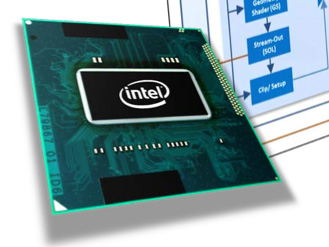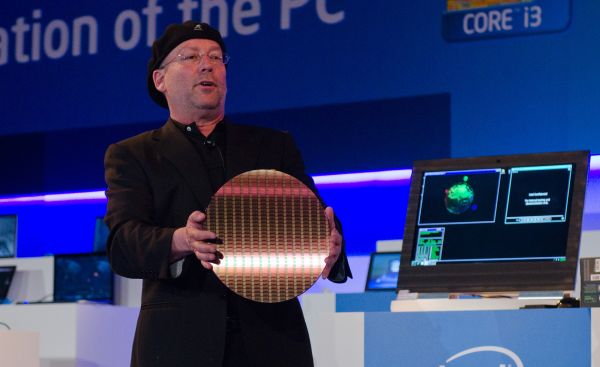Intel's Ivy Bridge Architecture Exposed
by Anand Lal Shimpi on September 17, 2011 2:00 AM EST- Posted in
- CPUs
- Intel
- Ivy Bridge
- IDF 2011
- Trade Shows
Five years ago Intel announced its ambitious tick-tock release cadence. We were doubtful that Intel could pull off such an aggressive schedule but with the exception of missing a few months here or there tick-tock has been a success. On years marked by a tick Intel introduces a new manufacturing process, while tock years keep manufacturing process the same and introduce a new microprocessor architecture. To date we've had three tocks (Conroe, Nehalem, Sandy Bridge) and two ticks (Penryn, Westmere). Sampling by the end of this year and shipping in the first half of next year will be Intel's third tick: Ivy Bridge.

Ivy Bridge (IVB) is the first chip to use Intel's 22nm tri-gate transistors, which will help scale frequency and reduce power consumption. As we already mentioned, mobile Ivy Bridge will be the first Intel CPU to bring four cores into a 35W TDP.
At a high level Ivy Bridge looks a lot like Sandy Bridge. It's still a monolithic die that features an integrated GPU. The entire die is built at 22nm, continuing Intel's march towards truly addressing integrated graphics performance. Ivy Bridge won't get rid of the need for a discrete GPU but, like Sandy Bridge, it is a step in the right direction.

Intel hasn't announced die size but transistor count has increased to approximately 1.4 billion (layout). This is up from 1.16 billion in Sandy Bridge, a 20.7% increase. With perfect scaling a 22nm Sandy Bridge die would be 47.3% the size of a 32nm die. Even with the increase in transistor count, it's a good bet that Ivy Bridge will be noticeably smaller than Sandy Bridge.
Motherboard & Chipset Support
Ivy Bridge is backwards compatible with existing LGA-1155 motherboards, although there will be a new chipset for Ivy Bridge and new motherboards to enable some features (e.g. PCI Express 3.0, native USB 3.0). The new chipset family falls under the 7-series banner. We'll see Z77, Z75, H77, Q77, Q75 and B75 available at or around launch.
| Chipset Comparison | ||||||||
| Z77 | Z75 | H77 | Z68 | P67 | H67 | |||
| CPU Support |
IVB LGA-1155 |
IVB LGA-1155 |
IVB LGA-1155 |
SNB/IVB LGA-1155 |
SNB/IVB LGA-1155 |
SNB/IVB LGA-1155 |
||
| CPU Overclocking | Yes | Yes | No | Yes | Yes | No | ||
| CPU PCIe Config |
1 x16 or 2 x8 or 1 x8 + 2 x4 PCIe 3.0 |
1 x16 or 2 x8 PCIe 3.0 |
1 x16 PCIe 3.0 |
1 x16 or 2 x8 or 1 x8 + 2 x4 PCIe 3.0 |
1 x16 or 2 x8 PCIe 3.0 |
1 x16 PCIe 3.0 | ||
| Processor Graphics Support | Yes | Yes | Yes | Yes | No | Yes | ||
| Intel SRT (SSD caching) | Yes | No | Yes | Yes | No | No | ||
| RAID Support | Yes | Yes | Yes | Yes | Yes | Yes | ||
| USB 2.0 Ports (3.0) | 14 (4) | 14 (4) | 14 (4) | 14 | 14 | 14 | ||
| SATA Total (Max Number of 6Gbps Ports) | 6 (2) | 6 (2) | 6 (2) | 6 (2) | 6 (2) | 6 (2) | ||
| PCIe Lanes | 8 (5GT/s) | 8 (5GT/s) | 8 (5GT/s) | 8 (5GT/s) | 8 (5GT/s) | 8 (5GT/s) | ||
As I mentioned above, Ivy Bridge finally supports USB 3.0 natively. The consumer 7-series chipsets feature 14 total USB ports, 4 of which are USB 3.0 capable. The CPU itself features 16 PCIe (1x16, 2x8 or 1x8 + 2x4) gen 3 lanes to be used for graphics and/or high performance IO. You will only see Gen 3 speeds on qualified motherboards. It's technically possible on 6-series motherboards but guaranteed on 7-series motherboards. The Z77 and H77 chipsets will support Intel's Smart Response Technology (SRT, aka SSD caching) which is a Z68 exclusive today.
SATA and chipset-attached PCIe slots haven't changed. Overclocking is supported on all Z-chipsets, while the H-chipset doesn't. All chipsets support Intel's HD Graphics, which is a departure from the Sandy Bridge mess where P67 didn't.










97 Comments
View All Comments
piroroadkill - Saturday, September 17, 2011 - link
I'd have liked a little more on this.. What's the source?I searched anyway, and found it is using thermal sampling. Presumably it's also seeded. Anyway, I thought it was of interest.
Jamahl - Saturday, September 17, 2011 - link
Don't you get tired of saying "intel is finally taking gpu performance seriously" every year? I do.JonnyDough - Monday, September 19, 2011 - link
I'd just like to say...=) Yes sir, I do.
imaheadcase - Saturday, September 17, 2011 - link
I heard when sandy bridge came out they was considering a GPUless version for enthusiasts who don't need it..is that something they will do eventually?I suspect its tied to the core, so not going to happen because of high costs. But wouldn't that save even more power/heat problems with that removed?
It just seems like its a mobile orientated cpu vs consumer. :D
DanNeely - Saturday, September 17, 2011 - link
With power gating if you're not using the IGP it doesn't consume any power; so the only thing they'd save on is die area by removing it.imaheadcase - Saturday, September 17, 2011 - link
Ah did not know that part. thanks.fic2 - Monday, September 19, 2011 - link
"I heard when sandy bridge came out they was considering a GPUless version for enthusiasts who don't need it..."Interesting since Intel did the exact opposite - put the only GPU with half decent performance into the enthusiast 'K' series.
JonnyDough - Monday, September 19, 2011 - link
The only people who would actually consider that are businesses and home users who don't play "real" games. :Pjjj - Saturday, September 17, 2011 - link
"I believe that x86 CPU performance is what sells CPUs today"That's not all that true anymore,there was a time when apps used by everybody required a fast CPU but that's not the case anymore nowdays..Just a few years ago playing HD content was a chalange on older systems but now ,if you look at usage paterns and what kind of perf is needed, the picture has changed. This is one of the reasons PC sales are not doing so great,there is no need to upgrade your system every 1-2 years.Even Windows is not driving system requirements up anymore.
In the consumer space GPU and battery life matter more now. Intel is trying to fight all this with lower power consumption, ultrabooks but that far from enough.If they want to survive the ARM "tsunami" (think about the financial part too here not just perf) , they got to push the software to be more demanding too and maybe the easiest is to do it on the GPU side -not in games.
MadMan007 - Saturday, September 17, 2011 - link
Intel's quarterly results say there is less to worry about than hyperbolic ARM domination headlines would lead one to think. One IDF slide showed large growth in emerging markets where the analysts aren't as able to get reliable data. Yes, PC upgrade cycles are longer, but that doesn't mean there is not net worldwide growth.There is room for growth in both areas, it's not a zero-sum game, and some things like mobile video consumption actually go hand-in-hand with faster beefy CPUs.